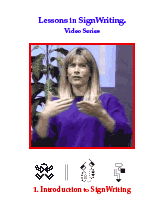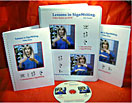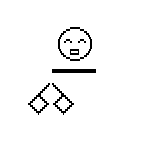|
CAPTION TRANSCRIPT
Cindy
Hi! My name is Lucinda O'Grady Batch. Welcome
to our video series "Lessons In Sign Writing".
This first video is called "Introduction to
Sign Writing".
Kevin Hello. My name is Kevin Clark. You know, I
have been involved with American Sign Language research
for some time now, so I want to learn SignWriting.
But I'm curious. What exactly is SignWriting used
for?
CindyThe two of us were born Deaf, from Deaf families.
We grew up using American Sign Language, or ASL,
our native language. We need a way to preserve our
language. SignWriting copies exact movements of
signs rather than using English to describe ASL
Kevin
Oh. I see.
I'm curious.
Who uses SignWriting?
Cindy
Sign Language researchers, hearing students who
need a way to write new signs, Deaf people who want
to write ASL poetry, plays, stories, in school education,
& also other countries, such as Norway, Denmark,
Ireland, & England are starting to write their
own signed languages using SignWriting.
Kevin
I see. That's good. You know, that makes sense because
spoken languages have a way to write their own languages.
But we as Deaf people, haven't really had a way
to write our signed languages. Now, with this system,
it seems possible to do that.
Cindy
Right.
The purpose of this video is to show a few handshapes,
movement, contact, and facial expressions, and to
show a sign sentence written in ASL. Now I'll teach....you
learn.
Let me explain the difference between the Receptive
and Expressive points of view. Receptive means watching
another person signing. Expressive means seeing
signs from your own perspective.
Back in 1981, we wrote signs Receptively, but we
learned through experience it is better to write
Expressively. Why? Because we're not demonstrating
signs. We are expressing our own language.
Here is the flat handshape. Remember we are using
the Expressive point of view. The palm of the hand
is always light. The side of the hand is one-half
dark, one-half light. The light shows where the
palm of the hand is facing. The back of the hand
is always dark.
The Flat Hand
Kevin
Do you have an example? Like the sign “to
know”?
Cindy
Yes. Let me show you a few things. The circle represents
the head. Look at the hand symbol. The dark part
means the “back of the hand”. The two
contact stars mean “two times contact”.
Kevin
So the two asterisks mean “two contacts”?
Cindy
Yes. That’s correct. The sign is “to
know”. It is from the Expressive point of
view. Imagine that you are looking through the back
of the head and feeling it on the right side of
the head.
Kevin
Can you represent exact locations on the head?
Cindy
Oh yes. We can do that. Let me show you the sign
for "know" lower on the cheek. The circle
represents the head. The handshape is at an angle,
touching the cheek. We have two stars for contact.
Next we have the facial expression with the mouth
up on the right side.
Kevin
So is this face looking out toward the viewer?
Cindy
Well, not really. Try to imagine looking through
the back of the head and feeling it for yourself
on the right side of your own face. In this diagram
one sign is for the right side, and the other one
is for the left side.
Left Side of Head
know
(hand on the left side)
Right Side of Head
know
(hand on the right side)
Left Side of Face
Pretend you can see through the back of the head.
You are reading and writing how your face "feels"
when you sign:
know
(mouth pushed up on the left side)
Right Side of Face
Pretend you can see through the back of the head.
You are reading and writing how your face "feels"
when you sign:know
(mouth pushed up on the right side)
This is the symbol for the fist. Look at the first
symbol at the top of the diagram. The palm of the
hand is a light square. Look at the second symbol.
It is one-half dark for the back of the hand, and
one-half light for the palm of the hand. The light
part shows where the palm of the hand is facing.
Then, looking at the third symbol, you see the back
of the fist, which is dark.
Now I will show you a sign. You can see there is
a square for the fist. Then you see circular movement
two times with the right hand. That’s the
sign for Saturday:
The Fist Hand
Saturday
Now let's look at the next symbol. Look at the first
symbol at the top. A line, representing the index
finger, is sticking out of the square for the fist.
The square is light because the palm is facing you.
In the second symbol, you see one-half dark for
the back of the hand, and one-half light for the
palm of the hand. In the third symbol, you see the
back of the hand, which is always dark.
Kevin
Is that handshape the “D” handshape?
Cindy
No. It is not a “D” handshape. It is
the “index” handshape. It is the closed
fist with the finger sticking up.
Here is a sign that uses the index hand. We have
a circle for the head. Then we have two places for
location showing where it is contacting on the face.
Then we have the hand symbol showing the index finger
and the contact star showing contact. It is the
sign for “Deaf”.
The Index Hand
Would
you like me to try writing this?
Kevin
Sure.
Cindy
Remember to write the sign, signed with the left
hand.
Deaf
(signed with the left hand)
Deaf
(signed with the right hand)
That is very good. Let us see if it fits. Perfect!
If you compare them. That’s the sign for “Deaf”.
Wonderful.
Now we have a sentence written in ASL, written from
left to right, just as English is written from left
to right. Let me explain a few things. Let us look
at the first sign. We have a circle for the head,
and two lines showing the eyebrows up. And then
we have the next sign which says “ASL”
in fingerspelling. And then you see two vertical
lines. Those two lines mean a pause, or a break.
In the next sign, you see the head with the eyegaze
looking right diagonally, and a facial expression
with a tense mouth. The hand is also moving two
times right diagonally, in the same direction as
the eyegaze. Then there is a thick line at the end
of the sentence, which means the “end of the
sentence”. An English translation of this
sentence might be: “Writing ASL from Deaf
people’s perspective".
Another way to write. We just saw the sentence going
across the page, but now we see it going down the
page. How did it happen that Deaf people started
writing down the page? Well, we Deaf people found
through experience that it was natural to write
down the page. We think perhaps it is connected
with space and location, but anyway, of course,
we are still experimenting.
Let me show you a few things that are different.
They are the same signs we saw written from left
to right across the page. They are now simply written
down the page. The two-lined symbol representing
a pause was vertical before. Now it is horizontal.
And the thick line marking the end of the sentence
is now horizontal as well:
eyebrows up
pause
Written
ASL ,end of
sentence
Deaf their perspective.
written
horizontally
Kevin
This seems more comfortable reading it this way.
Cindy
Yes. I think so. It seems that we Deaf people prefer
to write down the page, but of course, we are still
experimenting. Maybe we’ll throw out writing
from left to right , and start writing down the
page all the time. Who knows?!
Kevin
This seems to be printed by computer. Is that right?
Cindy
Yes. That’s right. This was printed by computer.
We have a computer program called “SignWriter®”
that is really a “sign language processing
program”, a little like a “word processing
program”, but now the signs pop up while you
are typing along the screen. It is a nice way to
write SignWriting.
I personally prefer to write by hand because way
back when I started writing SignWriting we had no
computers. Then computers came into the picture.
But other Deaf people love to type by computers.
Really, a person can continue to write by hand or
choose the computer. It’s their choice. It
really doesn’t matter.
Kevin
Yeah. It seems like this offers a person a choice
to write by hand or use the computer
Cindy
Yes. That’s right.
Well, I guess we are finished with this lesson.
.
Goodbye!!
If
you want information about SignWriting contact us!
Deaf Action Committee For SignWriting • P.O.
Box 517 • La Jolla • CA • 92038
USA • DAC@SignWriting.org • SignWriting
Web Site: https://www.SignWriting.org
|

















